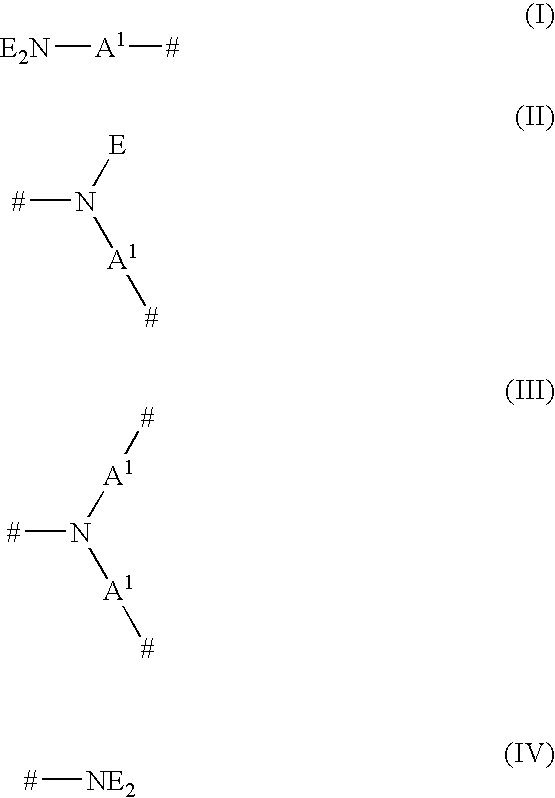Cleaning compositions with amphiphilic water-soluble polyalkylenimines having an inner polyethylene oxide block and an outer polypropylene oxide block
a technology of amphiphilic water-soluble alkylenimine and cleaning composition, which is applied in the direction of detergent composition, detergent compounding agent, liquid soap, etc., can solve the problems of reducing the cleaning ability of typical detergents, reducing the cleaning effect of grease, so as to improve the cleaning effect and reduce the surfactant level
- Summary
- Abstract
- Description
- Claims
- Application Information
AI Technical Summary
Benefits of technology
Problems solved by technology
Method used
Image
Examples
example 1
PE1600+24EO / NH+16PO / NH
[0061]a) PEI600+1EO / NH—In a 3.5 L autoclave of a polyethyleneimine (1184.0 g, approx. average Mw=600 g / mol) and water (205.0 g) were heated to 80° C. The autoclave was purged three times with nitrogen up to a pressure of 5 bar. After increasing the temperature to 120° C. ethylene oxide (908.7 g) was added in portions. The pressure was raised to 7 bar. To complete the reaction, the mixture was allowed to post-react for 2 h at 120° C. The reaction mixture was stripped with nitrogen and volatile compounds were removed in vacuo at 70° C. This procedure yielded 2305 g of a 91% by weight aqueous solution of polyethyleneimine alkoxylated by 1 mole of ethylene oxide per mole of NH-bond as a yellow viscous liquid. Amine titer: 11.22 mmol / g; pH (of 1% by weight aq. solution): 11.06.
b) PEI600+24EO / NH—In a 2 L autoclave the aqueous solution obtained in example 1.a) (108.6 g) and an aqueous solution of potassium hydroxide (50% by weight, 2.9 g) were heated to 80° C. The aut...
example 2
PEI 600+24EO / NH+24PO / NH
[0062]a) PEI 600+24EO / NH+24PO / NH—In a 2 L autoclave the alkoxylated polyethyleneimine obtained in example 1.b) (341.3 g) was heated to 80° C. The autoclave was purged three times with nitrogen up to a pressure of 5 bar. After increasing the temperature to 140° C. propylene oxide (425.5 g) was added in portions. The pressure was raised up to 6 bar. To complete the reaction, the mixture was allowed to post-react for 5 h at 140° C. The reaction mixture was stripped with nitrogen and volatile compounds were removed in vacuo at 80° C. This procedure yielded 780 g of a polyethyleneimine alkoxylated with 24 mole of ethylene oxide and 24 mole propylene oxide per mole of NH— bonds as a yellow viscous liquid. Amine titer: 0.36 mmol / g; pH (1% by weight aq. solution): 9.1; Iodine color number (pure compound, 40° C.): 7.3.
example 3
DETA+24EO / NH+24PO / NH
[0063]a) DETA+1 EO / NH—In a 2 L autoclave diethylene triamine (381.8 g) and water (19.1 g) were heated to 70° C. The autoclave was purged three times with nitrogen up to a pressure of 5 bar. After the temperature had been increased to 90° C. ethylene oxide (814 g) was added in portions. The pressure was raised up to 3 bar. To complete the reaction, the mixture was allowed to post-react for 2 h at 90° C. The reaction mixture was stripped with nitrogen and volatile compounds were removed in vacuo at 70° C. This procedure yielded 1180 g of diethylene triamine alkoxylated with 1 mole of ethylene oxide per mole of NH— bonds as a yellow viscous liquid.
b) DETA+24EO / NH—In a 2 L autoclave diethylene triamine alkoxylated with 1 mole of ethylene oxide per mole NH bond obtained in example 3.a) (79.7 g) and an aqueous solution of potassium hydroxide (50% by weight, 2.9 g) were heated to 80° C. The autoclave was purged three times with nitrogen up to a pressure of 5 bar. Water ...
PUM
| Property | Measurement | Unit |
|---|---|---|
| pressure | aaaaa | aaaaa |
| temperature | aaaaa | aaaaa |
| temperature | aaaaa | aaaaa |
Abstract
Description
Claims
Application Information
 Login to View More
Login to View More - R&D
- Intellectual Property
- Life Sciences
- Materials
- Tech Scout
- Unparalleled Data Quality
- Higher Quality Content
- 60% Fewer Hallucinations
Browse by: Latest US Patents, China's latest patents, Technical Efficacy Thesaurus, Application Domain, Technology Topic, Popular Technical Reports.
© 2025 PatSnap. All rights reserved.Legal|Privacy policy|Modern Slavery Act Transparency Statement|Sitemap|About US| Contact US: help@patsnap.com



